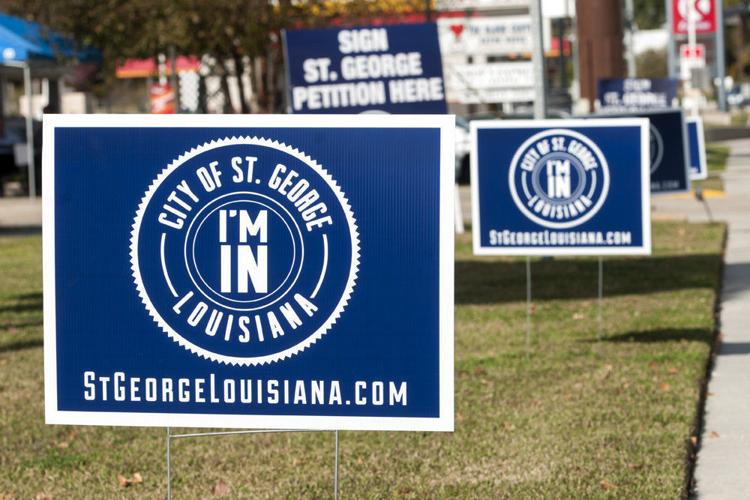The future transfer of Bluebonnet Boulevard and several other state roads to Baton Rouge's city-parish government potentially could serve as pathways for Baton Rouge to annex businesses and residences from inside the boundaries of the new city of St. George.
The groundwork for such a process was used two years ago when Siegen Lane Marketplace — surrounded by the then-proposed St. George area — was carved out of St. George's potential business tax base into Baton Rouge. The annexation application used city roads near the Mall of Louisiana and city-owned property tracking along Ward's Creek as links to establish that Siegen Lane Marketplace was contiguous to Baton Rouge's city limits and therefore was accessible for annexation.
Already this week, owners of a five-story commercial office building off Essen Lane have filed a petition to remove it from St. George's boundaries, taking $60,800 in annual taxes off the table for the new city.
The owners of a five-story United Plaza office building off Essen Lane are the first to try to break away from the newly created city of St. G…
Charles Landry, a prominent attorney who filed that petition and also was involved in the Siegen Lane Marketplace annexation, looks to take advantage of Bluebonnet as city-parish property to file petitions for property owners whose land touches the boulevard and want to be annexed into Baton Rouge.
Bluebonnet Boulevard — between Interstate 10 and La. 30 — is likely the next state road to be transferred to Baton Rouge city-parish government as part of a statewide program.
"If it's a city-parish road under state legislation you can use the right-of-way of the road to link the city to another piece of property, that's the importance of this transfer program," Landry said. "It's like a flag on a pole, the pole is the road leading to the property and the property is the flag."
Other roads that already have a transfer agreement between the state and Baton Rouge are Perkins Road between Siegen Lane and Interstate 10; Siegen Lane between Burbank Drive and Airline Highway; Highland Road between Siegen Lane and Interstate 10; and Jefferson Highway between Airline Highway and La. 42.
Meanwhile, sections of Jefferson Highway, Airline Highway and I-10 will remain in the state highway system.
The potential number of businesses with properties that touch city limits could be greatly expanded after the state transfers of the state roadways.
Drew Murrell, an attorney and St. George organizer, doesn’t anticipate the road transfers and potential subsequent annexations to put a dent in the new city’s tax rolls.
Murrell also said he’s been approached by residents and commercial property owners alike about being annexed by St. George from Baton Rouge. Murrell said he isn’t concerned about the future state road transfers and suggested that the influx of a new tax base could cover any properties leaving its boundaries.
“We do have a lot of inquiries about being annexed in,” Murrell said. But the new city can’t yet accept any petitions until it has leadership appointed by the governor of Louisiana.Â
Road work on Bluebonnet is expected to wrap up by the end of October and then the transfer process will continue, but there is no time restriction or estimate as to when it will be completed, according to the Louisiana Department of Transportation and Development.
"This depends on the final acceptance and how long the act of transfer takes," said Rodney Mallett, spokesperson for DOTD. "There is no timeline. Most of the routes will be repaired prior to transfer and that can take quite a while."
Once Bluebonnet is transferred to control of Baton Rouge, property owners could use the road as a gateway in annexation cases that reach further into St. George. Properties are only eligible to be annexed into the city of Baton Rouge if contiguous to the existing boundaries of the city.Â
There is currently a buffer of unincorporated East Baton Rouge Parish between the city of Baton Rouge and St. George between Perkins Road and La. 30 along Bluebonnet where there are dozens of commercial businesses.Â
The potential flight of commercial properties across St. George, which often cluster along major roads, could significantly erode the tax base of the fledgling city.
Landry four years ago represented several major commercial centers carved out of the then-proposed St. George area into Baton Rouge's city limits. Those properties included most of the Mall of Louisiana, Our Lady of the Lake Regional Medical Center and Baton Rouge General's Bluebonnet campus.
His filing this week would carve the Four United Plaza building off Essen Lane out of St. George. The north side of Essen Lane is unincorporated East Baton Rouge Parish, while St. George city limits sit on the south side of the road. In this case, a stretch of United Plaza Boulevard that touches Essen Lane is proposed to be annexed into the city, then the United Plaza property itself can be annexed.Â
Murrell suggested that Landry in particular is invested in the future of Baton Rouge after building years of political clout and high profile clients.
“He’s a Baton Rouge insider who has made a lot of money off Baton Rouge,” Murrell said. “We played by the rules and we won. I think that this is just sour grapes.”
Murrell said those requesting annexation into the city of Baton Rouge can be expected to pay higher property taxes since those properties were previously in unincorporated areas. He said that would be a bad deal for property owners.
“I think it’s just an excuse for them to annex, is that the reason (Mayor Sharon Weston-Broome) took over Bluebonnet from the state?” Murrell questioned.
He suggested it was suspicious how many of the state roads that cut through St. George will eventually be controlled by the city-parish amid the organizing efforts to create St. George.
“We always thought that it was pretty odd,” Murrell said.














